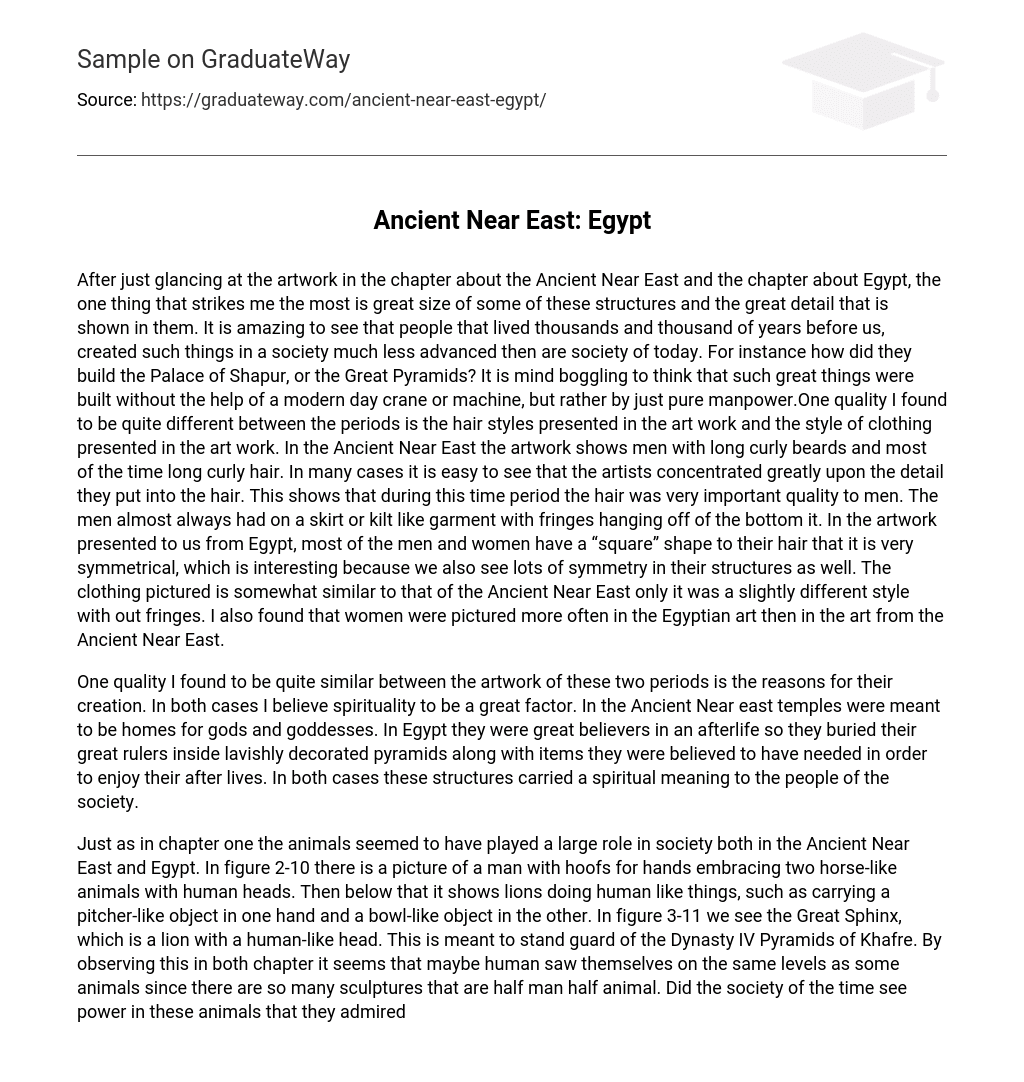After just glancing at the artwork in the chapter about the Ancient Near East and the chapter about Egypt, the one thing that strikes me the most is great size of some of these structures and the great detail that is shown in them. It is amazing to see that people that lived thousands and thousand of years before us, created such things in a society much less advanced then are society of today. For instance how did they build the Palace of Shapur, or the Great Pyramids? It is mind boggling to think that such great things were built without the help of a modern day crane or machine, but rather by just pure manpower.One quality I found to be quite different between the periods is the hair styles presented in the art work and the style of clothing presented in the art work. In the Ancient Near East the artwork shows men with long curly beards and most of the time long curly hair. In many cases it is easy to see that the artists concentrated greatly upon the detail they put into the hair. This shows that during this time period the hair was very important quality to men. The men almost always had on a skirt or kilt like garment with fringes hanging off of the bottom it. In the artwork presented to us from Egypt, most of the men and women have a “square” shape to their hair that it is very symmetrical, which is interesting because we also see lots of symmetry in their structures as well. The clothing pictured is somewhat similar to that of the Ancient Near East only it was a slightly different style with out fringes. I also found that women were pictured more often in the Egyptian art then in the art from the Ancient Near East.
One quality I found to be quite similar between the artwork of these two periods is the reasons for their creation. In both cases I believe spirituality to be a great factor. In the Ancient Near east temples were meant to be homes for gods and goddesses. In Egypt they were great believers in an afterlife so they buried their great rulers inside lavishly decorated pyramids along with items they were believed to have needed in order to enjoy their after lives. In both cases these structures carried a spiritual meaning to the people of the society.
Just as in chapter one the animals seemed to have played a large role in society both in the Ancient Near East and Egypt. In figure 2-10 there is a picture of a man with hoofs for hands embracing two horse-like animals with human heads. Then below that it shows lions doing human like things, such as carrying a pitcher-like object in one hand and a bowl-like object in the other. In figure 3-11 we see the Great Sphinx, which is a lion with a human-like head. This is meant to stand guard of the Dynasty IV Pyramids of Khafre. By observing this in both chapter it seems that maybe human saw themselves on the same levels as some animals since there are so many sculptures that are half man half animal. Did the society of the time see power in these animals that they admired? They must have had a lot of pride in these animals if they gave them human-like qualities.
Through the artwork I have seen I would have to say that Egypt was much more advanced then the Ancient Near East. In Egypt we see huge symmetrical columns such as in figure 3-19. We also find that the pyramids are also symmetrical. They built similar structures in the Ancient Near East lacking symmetry as compared to Egypt where symmetry seemed to have played a large roll. Although Egypt seemed more advanced in they way they designed their structures, it is shown that in both cultures that hunting was still a very important way of life just as it was in the prehistoric times.
In conclusion, I don’t think it would be fair to just show all of the similarities or just all of the differences between the cultures of the Ancient Near East and Egypt because there are just so many on both sides of the picture. It is Important to see the differences in two different cultures and understand them because this shows us advancement between to cultures. It is also important for us to see some similarities because it still shows us that there is a connection between all the cultures that have existed in society.Bibliography:none





